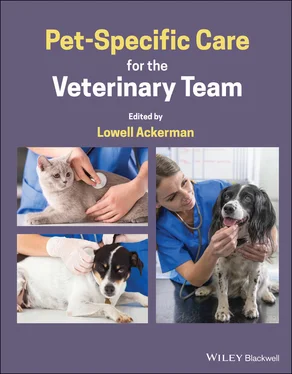 BASICS
BASICS
2.18.1 Summary
The need to reproductively manage owned and feral dogs and cats is the driving force behind gonadectomy. Excision of sex organs (neutering, desexing) prevents procreation, which is of particular importance when considering the sheer numbers of animals that are relinquished to animal shelters annually. There is only so much room to accommodate new arrivals, and traditional shelters are often forced to euthanize otherwise healthy patients in the face of space constraints. Sterilization surgery is considered the norm in North American dogs and cats, and is increasingly performed at young ages to (i) prevent breeding of adopted dogs, and (ii) potentially reduce behaviors that may lead to relinquishment. Early‐age gonadectomy is not without risk, which has led to increasing interest in reversible contraception, as opposed to the traditional ovariohysterectomy (OVH) and castration. These methods run the gamut from extra‐label use of human contraceptives to intratesticular injections.
Gonadectomy:Technically, surgical removal of an ovary or testis; colloquially, this term often refers to excision of the reproductive tract and is therefore synonymous with ovariohysterectomy or castration.
Orchiectomy:Surgical excision of both testicles; synonymous with the term castration
Ovariectomy (OVE ):Surgical removal of one or both ovaries, leaving the uterus intact.
Ovariohysterectomy:Surgical excision of the ovaries and uterus.
Reversible Contraception:A method of preventing pregnancy that does not result in permanent sterilization, such that if pregnancy is desired at a later point, removal of this method makes this physiological state possible.
 MAIN CONCEPTS
MAIN CONCEPTS
2.18.3 The Reason for Sterilization
The primary purpose of gonadectomy is to manage canine and feline populations [1]. American animal shelters collectively report an estimated intake of 6.5 million companion animals annually [2]. Permanent sterilization prevents unplanned pregnancies that yield unwanted litters, which ultimately end up at shelters [3–7].
The majority of American veterinarians advocate for elective sterilization surgery [8]. Most American dogs and cats undergo elective OVH or castration within their first year of life. The recommended age for such surgeries often varies with breed, stage of growth, and underlying risks for potential medicals conditions, such as inherited orthopedic problems.
Gonadectomy reduces the risk for mammary neoplasia, particularly if females are spayed before the first heat cycle [6, 9–14]. Male dogs that are castrated are less likely to develop hormone‐dependent benign prostatic hypertrophy (BPH) [9].
Neutering also curbs unfavorable behaviors: castrated male dogs roam, mount, and urine‐mark less frequently, and male cats are less likely to spray [9, 15].
2.18.4 The Rise of Pediatric Neutering
Waiting to sterilize patients until they are 6 months of age or older runs the risk that they will reach sexual maturity and procreate. Because of this concern, pediatric neutering is on the rise. Shelters also do not wish to adopt out intact patients that then may reproduce, particularly since unwanted litters are often relinquished back to shelters [1, 7, 9].
In an effort to break this cycle, OVH and castration are now routinely performed at 6–16 weeks of age [4, 6, 8, 9]. Safe anesthetic protocols have been established and patients that undergo early‐age gonadectomy experience fewer perioperative complications [9, 16, 17].
2.18.5 Ovariectomy Versus Ovariohysterectomy
Ovariohysterectomy is the standard sterilization surgery for bitches and queens in the US. Removing the uterus prevents uterine pathology [18]. However, uterine tumors are infrequent. Most that occur are benign and surgery is curative [18].
Ovariectomy has replaced OVH in the Netherlands and much of Europe. Because OVE spares the uterus, the procedure is associated with smaller incisions. OVE may also be performed as a minimally invasive technique using laparoscopy [19].
2.18.6 Alternatives to Permanent Sterilization
Because permanent sterilization is not considered medically or ethically appropriate by all nations and cultures, research interest in reversible contraception has grown [6, 20]. Synthetic progestins, such as megestrol acetate (MA) and medroxyprogesterone acetate (MPA), may be administered to suppress follicle‐stimulating hormone (FSH) and luteinizing hormone (LH), without which follicles will not mature to ovulation [3, 21]. Adverse effects may be significant, particularly in cats [21, 22].
Other methods of reversible contraception that are being explored include [3, 21, 23–32]:
prolonged exposure to gonadotropin‐releasing hormone (GnRH) agonists
canine intrauterine devices (IUDs)
chemical castration with intratesticular injectable agents such as arginine stabilized zinc gluconate, chlorhexidine digluconate, calcium chloride admixed with dimethyl sulfoxide, etc
mechanical castration, using ultrasound to induce testicular necrosis
vaccinations against LH and GnRH, spermatozoa, or zona pellucida proteins
melatonin implants.
 EXAMPLES
EXAMPLES
Toblerone is a 1‐year‐old intact female Great Dane that presents to you for elective surgical sterilization. Given the breed's predisposition to gastric‐dilation volvulus (GDV), the client is interested in prophylactic gastropexy at the time of OVH. However, he worries about intraoperative hemorrhage and the large incision. You indicate that there is an alternative to the traditional laparotomy that is required to perform both procedures. You suggest that the patient undergoes laparoscopic OVE and gastropexy.
 TAKE‐AWAYS
TAKE‐AWAYS
Pet overpopulation is a global, multifaceted, animal welfare issue.
Sterilization surgery is considered the standard of care in the US as a means of population control.
Early‐age gonadectomy is increasingly common given that safe anesthetic protocols have been developed.
The desire for less invasive procedures has led to the successful adoption of OVE in other countries.
Research is growing in the area of reversible contraception.
 MISCELLANEOUS
MISCELLANEOUS
2.18.7 Cautions
Gonadectomy is not without risk. Surgical complication rates vary from study to study; however, as many as 6.1–27% of bitches and 2.6–33% of queens experience postoperative complications [9, 33].
Obesity is common among neutered dogs and cats [6, 10]. In addition, neutered dogs are at greater risk of developing:
Читать дальше

 BASICS
BASICS MAIN CONCEPTS
MAIN CONCEPTS EXAMPLES
EXAMPLES TAKE‐AWAYS
TAKE‐AWAYS MISCELLANEOUS
MISCELLANEOUS










